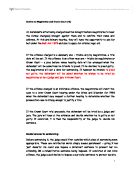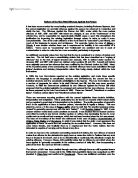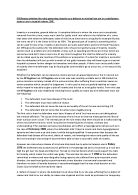AS level Criminal Paper
Criminal law part A Actus Reas is described as the physical element. For a criminal case to win actus reas must be proved and also along with mens rea. An Actus reas can be committed in three different ways. Firstly, the omissions of a person meaning they have failed to do something that an existing duty required by you. There are two kinds of omissions common law and statutory. Statutory for example would be failure to supply a breathe sample when stopped on suspicion of drink driving violating the Road Traffic act 1988 section 2. However, common law duties can be split up into 5 parts. . A duty will arise from a relationship towards people who are dependent on others. For example a parent towards a child owes responsibility for foreseeable harm towards the vulnerability of a child. Such as in R v Gibbons and Proctor. 2. Were by a duty that has voluntarily been undertaken a duty will still exist, as the same standard will be expected of you. Such as in R v Stone and Daganson. 3. A contractual duty will arise. For example R v Pittwood 4. A professional duty will arise such as a doctor, police officers. As shown in R v Dytham. 5. Also, a duty will arise were failure to stop a situation in getting worse in which you have started. Such as in R v Santana Barmudes were by failure to state there were needles in his pocket causing a police officer to get pricked by one. Also
Law A2 unit 4 murder problem answer plan
June 2004 practise paper - Law Homework (B) Discuss Charles criminal liability for the unlawful homicide (involuntary manslaughter, murder, voluntary manslaughter) in connection with Derek's death. Involuntary manslaughter is an unlawful killing where the DF doesn't have the intention to kill or to cause GBH. There are two ways of committing involuntary manslaughter - unlawful act manslaughter, and gross negligence manslaughter. Unlawful or constructive act manslaughter is when the defendant has cause the death of the victim by committing an unlawful act. The burden of proof rests with the prosecution to proof beyond all reasonable doubt that the DF is guilty of committing this offence. The actus reus is the unlawful killing of a human being under the queens peace, but it must also include an unlawful act dangerousness which causes the death of the victim. The dead body is the body of Derek who drowned, which was an unlawful killing as he drowned and no one saved him from drowning, and it was under the Queens peace as it wasn't during a time of war, Charles and Derek weren't soldier on duty and they had to official duty to kill such as in the recent case of a supposed terrorist on a train who police had permission to shoot as they thought he was going to kill the whole train - by killing one person they were saving all the rest of the people on the train. The
Discuss whether trial by jury should be retained or abolished.
Discuss whether trial by jury should be retained or abolished Juries have and remain to be a core of our legal system, and evidence of 'trial by peers' can be traced back to 1215. In Bushell's Case (1670) it shows that by the seventeenth century the role of the jury as 'masters of the facts' had been established. In favour of retaining the jury role, it has obviously been used from this length of time without any setback and is the primary function of a criminal case (Crown Court and above) being used successfully for years. In our legal system, a jury trial will always seem to prevail in justice, as put by David Bean QC ex-chairman of the Bar Council, 'the evidence is clear: people trust juries'. As long as laymen are involved in the legal proceedings of a criminal case in some fashion, it proves that our legal system is comprehensible and that people can rely on 'normal' people providing the outcome for a case. Jury trial should be retained as when selecting a jury it is wholly random, providing many different people from different social backgrounds with plenty of different perspectives. If jury trial was to be abolished, and a single judge would merit the case, there would only be one narrow perspective, rather than twelve perspectives. This is also the case since members of the public see judges as upper class people, usually originating from public schooling with
What is the procedure for bail and sentencing after a criminals charge?
Outline to Magistrates and Crown Court (10) All defendants after being charged must be brought before magistrates to hear the formal charge(s) brought against them and to confirm their name and address, At this preliminary hearing, they will have the opportunity to ask for bail under the Bail Act 1976 and also to apply for criminal legal aid. If the offence charged is a summary one - triable only by magistrates, a trial date will be set. If the offence is an either-way one - triable by magistrates or Crown Court - a plea before venue hearing date will be arranged when the defendant will be asked how he intends to plead. If he decides to plead guilty, the magistrates will set a date for sentencing. If however he intends to plead not guilty, the defendant will be asked whether he wishes to be tried by magistrates or by a judge and jury in Crown Court. If the offence charged is an indictable offence, the magistrates will remit the case to a later Crown Court hearing under the Crime and Disorder Act 1998 when the defendant may request a further hearing to determine whether the prosecution case is strong enough to justify a trial. If the Crown Court trial proceeds, the defendant will be tried by a judge and jury. The jury will hear al the evidence and decide whether he is guilty or not guilty. If convicted, it is then the responsibility of the judge to decide his sentence.
Actus reus
'Law should encourage citizens in their civil duty to "do the right thing" in a moral sense and not turn a blind eye or fail to act to help someone who is in need.' Consider to what extent the criminal law relating to commission reflects this view. Omission is when the defendant does nothing to prevent the victim's death. In certain circumstances, D may be under a duty to take positive steps to assist V, and if D fails to take those steps then he can be liable for murder or manslaughter. If D is liable for V's death, he must be under a duty to act in the circumstances, otherwise he will escape liability. This was shown in Khan and Khan, in this case D escaped liability as there was no imposition of duty of care. Duty of care can be owed in a variety of situations. One of these situations is when duty arises out of contractual liability; where failure to fulfil a contract is likely to endanger lives, the criminal law will impose a duty to act. The duty is owed to anyone who may be affected, not just the parties to the contract. This was demonstrated in Pittwood, where D's argument was rejected as his duty was owed to the railway company as well as to those who were affected. Duty of care can also arise out of relationship; this was shown in Gibbons and Proctor. The father owed V duty of care as he was related to her; however his lover, P, was not related to V but was
Outline the range of duties undertaken by lay magistrates. Comment on how well Lay magistrates carry out this valuable role?
Law . a. Describe how lay magistrates are chosen and appointed? Lay magistrates, justices of the peace, are part-time and unpaid members of the public, who are chosen to serve in the magistrate's court. There are currently 28,253 lay magistrates in England and this figure is always growing. Lay magistrates are unpaid volunteers who could be a taxi driver, teacher or even a builder. The secretary of state for constitutional affairs and the Lord Chancellor on the advice of local advisory committees appoints the lay magistrates. However in order to become a lay magistrate a certain criteria is set. They only need to fit this certain criteria to become a lay magistrate. The person must live within 15 miles of the area in which they want to serve. They must have lived within this area for at least 12 months. There are other points to meet, such as the age limit of 21-65. However it is unlikely for someone to be chosen as a lay magistrate until the age of 27. However European legislation laws can make it so a person can become a lay magistrate. The person must also be able to sit for long periods of time and so must be healthy enough to fulfil their duties. The final criteria is that the person must be able to sit for at least 26 times a year, usually each time consists of half of a day and so must be able to sit for 13 days. This means they must be able to take off work and
Discuss the Criminal Liability of Dave for the murder of Edward
Dave may be liable for the murder of Edward. Murder is a common law offence, developed through case law. It is described by Sir Edward Coke in 1797 as "When a man of sound memory and of the age of discretion unlawfully killeth within any country of the realm any reasonable creature in rerum natura under the King's peace, with malice aforethought either express by the party or implied by law, so that the party wounded or hurt die of the wound or hurt within a year and a day.' The latter year and a day rule was abolished by the Law Reform (Year and A Day Rule) Act 1996. The short definition of murder is to cause the death of a human being with malice aforethought. The Actus Reus of murder is to cause the death of a human being. In this case, Dave has attacked Edward with a knife, causing a wound which led to the victim bleeding to death. There are no causation issues to deal with since there were no intervening acts, and it can be easily shown that the actus reus is satisfied. The Mens Rea of murder is an intention to kill or an intention to cause GBH. Murder is a specific intent offence, meaning that it can only be committed with intention. Since Dave has taken up a knife, it could be argued that he must have at least an intent to wound, which satisfies the intention for GBH, since a knife is a weapon which can only cause a wound at the minimum. It may not be evident that
Law should encourage citizens in their civic duty to do the right thing(TM) in a moral sense and not turn a blind eye or fail to act to help someone who is in need(TM). Consider to what extent the criminal law r
'Law should encourage citizens in their civic duty to do 'the right thing' in a moral sense and not turn a blind eye or fail to act to help someone who is in need'. Consider to what extent the criminal law relating to omissions reflects this view. Generally speaking, English law only punishes those who cause a prohibited act, although this may be a positive one. There is no general duty to act in order to do good deeds. There may well be a moral obligation on someone to be a 'good Samaritan' but there is not a legal one. However, Parliament and the courts find people criminally liable when they fail to act where responsibilities and duties of care are involved. It is not accepted that individuals should be criminally liable for failing to go to the assistance of those who find themselves in some kind of distress. Nevertheless, English law does punish those who fail to act under three situations. The first is where a statute actually imposes a duty. One example of this is the Road Traffic Act 1988, in which lays down situations where failing to act leads to an offence. This may be not stopping at a scene of an accident, found in s.170. The Children and Young Persons Act 1933 also does this. Such failures in feeding, clothing and sheltering children may lead to the offence of gross negligent manslaughter. Acts of Parliament ensure that people who fail to act appropriately
provocation essay
Carl is liable for murder or manslaughter and then considers any defences he may have available. The definition of murder comes from Lord Coke, the unlawful killing of a human being under the Queen's Peace with malice aforethought. Malice aforethought means an intention to kill or an intention to do serious harm. When Carl throws the third knife and pierces Victoria's heart there is an argument that he may have directly intended to kill her. His motive, jealousy, may have been a factor but it is not relevant in law. For direct intent to apply he must have the aim, purpose or desire, Mohan. As Carl regards his technique as perfect it seems that he may well have had a direct intent to kill as there appears to be no other explanation for his error. He is not intoxicated. Also the fact that it is the third knife would suggest that he was able to control his throwing of the first two as normal so making it all the more likely he intended to kill with the third. If Carl is charged with murder he may have two special and partial defences available to him under the Homicide Act 1957 which would reduce his conviction to voluntary manslaughter and allow the judge discretion on sentencing. These are S.2, diminished responsibility and S.3 provocation. To plead diminished responsibility he would have to bring medical evidence to show that he was suffering from an abnormality of the
Explain what is meant by the term 'causation' in criminal law and assess how the courts have interpreted its significance in determining criminal liability.
In criminal law, an act or omission that produces a consequence is called causation. To prove that the consequence was caused by the defendant’s act, the prosecution must show that; the defendant’s conduct was the factual cause of the consequence, it was the legal cause of the consequence and there was no intervening act from the victim or a third party that broke the chain of causation. To test whether the defendant’s conduct was the factual cause of the consequence, the ‘but for’ test is used. This tests whether the consequence would have happened but for the defendant’s act or omission. An example case where the ‘but for’ test was used is Pagett (1983), where the defendant took his girlfriend hostage, then when police called on him to surrender, he came outside using the girl as a human shield and opened fire. When the police returned fire, they killed the girlfriend. Because the police wouldn’t have shot the girl ‘but for’ the defendant’s conduct, the defendant was liable for manslaughter. An example where the ‘but for’ test was not satisfied was White (1910), where a man poisoned his mother’s drink in an attempt to kill her. She died before she drank the tea, and therefore he was not the factual cause of death and not guilty of murder, however, he was guilty of attempted murder. The second half of causation is whether the defendant’s


























